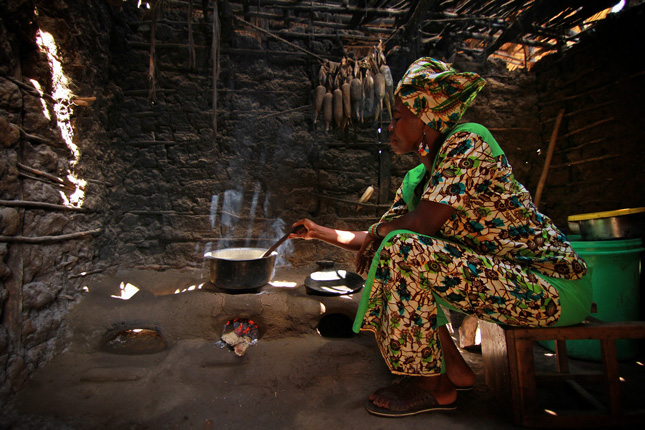-
Clean Cookstoves Provide Health, Environmental, and Socioeconomic Benefits, So Why Aren’t They Being Adopted?
December 29, 2014 By Tim Molnar
To stop and perhaps one day reverse climate change requires changes big and small. Despite the thousands of power plants burning coal and other fossil fuels today, nearly 3 billion people still depend on solid fuels, such as wood, dung, and crop residues, for their daily energy needs.
Nearly 3 billion people still depend on solid fuels for their daily energy needs
These fuels are gathered from nearby or bought at local markets and burned in small cookstoves. According to the World Health Organization, emissions from cookstoves kill 4.3 million people annually through indoor smoke inhalation and respiratory disease, and the Intergovernmental Panel on Climate Change reports black carbon – produced by a number of sources, including cookstoves – is the second most important climate-forcing anthropogenic pollutant.
A new generation of “clean cookstoves,” however, has the potential to reduce harmful emissions, increase efficiency, and improve health and livelihoods, especially for women (after high blood pressure, household air pollution is the leading global disease burden for women).
Yet clean cookstoves are not one-size-fits all. They must be tailored to local culture to be adopted and require long-term investment for sustainable use.
Tried and Tested
From a technological standpoint, clean cookstoves are easy to produce and use. Current designs, such as the Plancha Stove, in use across much of Latin America, are capable of reducing kitchen pollution levels by 90 percent. Similar to a conventional chimney, the Plancha Stove simply channels pollutants outside the house.
Large-scale dissemination plans are well under way
Large-scale clean cookstove dissemination plans are also well under way. The China National Improved Stove Program has disseminated more than 180 million clean cookstoves. The Global Alliance for Clean Cookstoves, established by the United Nations Foundation in 2010, is ahead of its goal of distributing 100 million nontraditional cookstoves by 2020. And clean cookstoves have been included in integrated population, health, and environment (PHE) interventions in Tanzania, where they helped empower women by creating a source of income and contributed to more sustainable livelihoods. Success stories such as these can be found all over the developing world.
Yet research has shown that stoves ill-suited to meet specific household needs often go unused, negating intended health gains and wasting financial investments. A case study in Orissa, India, for example, found that just six percent of the 2,600 households who were provided clean cookstoves used them properly. Difficulties with cleaning the stove, differences in taste of the foods being prepared, and increased preparation time were central concerns that discouraged use.
Embrace Variety
Household cooking needs vary greatly across the world, dictated by cultural differences in taste, customs, and food availability. Different cooking surfaces are needed to prepare Guatemalan corn tortillas as opposed to Ethiopian injera, for example, and clean cookstoves must be responsive to these differences.
The Global Alliance for Clean Cookstoves lists 193 stove variations in their catalog – there are options related to combustion fuel, number of burners, and stove material (brick, cement, ceramic, metal, and clay). Linking the right stove with local cooking culture encourages stove use and reduces stove modification (which often reduces efficiency).
Too many interventions don’t succeed because of unique local dynamics
Socioeconomic factors are also important. Charging for stoves may restrict use among the most disadvantaged households. Yet, payment has also been shown to increase proper use by creating pride in ownership. The Planeterra Foundation, which works with the Maasai tribe in Tanzania, asks for a $15 contribution from each recipient family to offset stove costs and has dispersed more than 750 stoves.
Clean cookstoves can even enhance livelihoods through local production or maintenance. In rural India, artisanal stoves are made using local natural resources, stimulating economic development and strengthening connections between producers and consumers. In the Purépecha region of Mexico, community members were trained to become service technicians, increasing the long-term viability of the stoves while also creating jobs.
Cultural Factors Key to Adoption
Such efforts are not one-size-fits-all solutions. In some regions, artisanal stove production may be impractical; in others, imported stoves have higher energy efficiency, less pollutants, and may be seen as a luxury good, therefore enhancing desirability.
While the technology and distribution networks exist to spread clean cookstoves on a large scale, too many interventions don’t succeed because of these unique local dynamics. Programs that consider location-specific social and cultural drivers are more likely to have success.
With nearly 4 in 10 people relying on solid fuels for their daily energy, clean cookstoves remain a remarkable opportunity, and the sheer number of existing programs gives implementers a tremendous variety of examples and experiences to build on.
Clean cookstove programs should look to the success and failures of others to learn what works and what doesn’t, considering cultural, economic, and social concerns to maximize their fit for the local context.
Tim Molnar is a graduate student in environmental studies at the University of Colorado, Boulder, focusing on renewable energy issues in developing countries.
Sources: Ecological Economics, Energy for Sustainable Development, Energy Policy, Environmental Health Perspectives, Global Alliance for Clean Cookstoves, Intergovernmental Panel on Climate Change, Lancet, The National Bureau of Economic Research, Planeterra, University of Colorado, Boulder, The World Bank, World Health Organization.
Photo Credit: A woman cooks with a clean cookstove in the short film, ‘Healthy People, Healthy Environment: Integrated Development in Tanzania,’ courtesy of Sean Peoples and Michael Miller/Wilson Center.
 A Publication of the Stimson Center.
A Publication of the Stimson Center.



